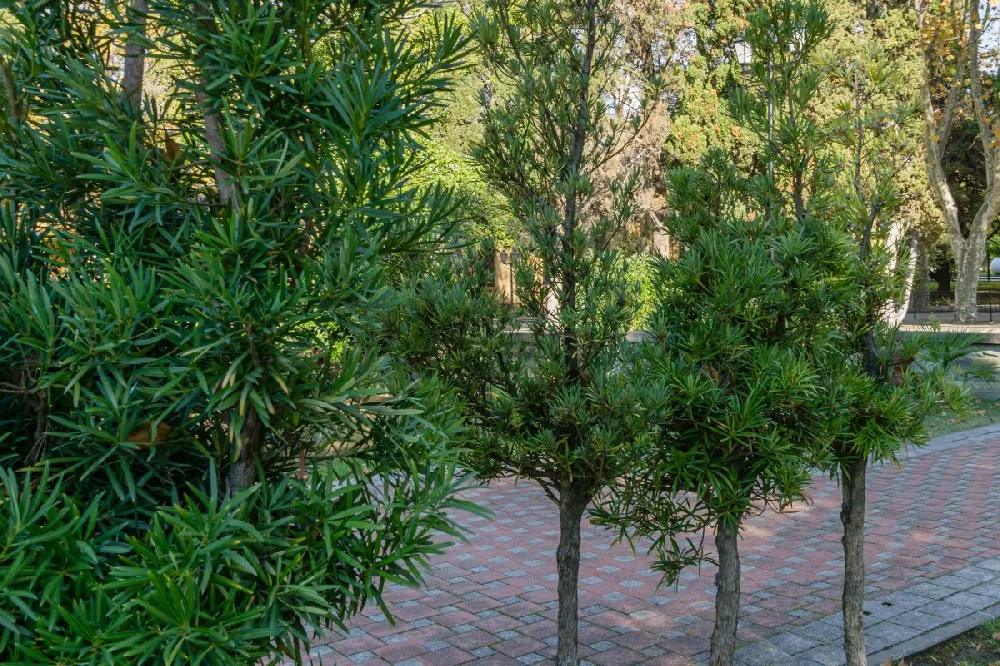- Home >
- Evergreen Trees >
- Fern Pine Columnar Tree
Fern Pine Columnar Tree for Sale - Buying & Growing Guide
Anyone living in a warm region who is looking for a fantastic evergreen plant should give the Fern Pine Columnar Tree a try. This species, known botanically as Podocarpus gracilior, has long evergreen leaves, develops in a neat columnar form, and is ideal for hardiness zones 9 through 11. The Fern Pine Columnar Tree is also an easy-to-care-for plant option. It not only grows relatively quickly without the need for much fertilization, but it is also drought-tolerant once established.
- The Fern Pine Columnar Tree has beautiful evergreen foliage.
- This tree has a neat and narrow growth habit.
- This species has excellent drought tolerance.
Enter your zip code to find nearby stores that may carry this plant.
Plant Care
Sunlight

You can grow a Fern Pine Columnar Tree in areas that receive partial shade or full sunlight.
Watering
Water this plant about once per week throughout the growing season.
Fertilizing

Apply a standard garden fertilizer once per year during the spring.
Planting and Care
Planting instructions
You can plant the Fern Pine Columnar Tree in nearly any planting area in zones 9 through 11 that receives between four to eight hours of direct sunlight per day. The soil in your planting locations should have good drainage and at least a moderate amount of organic nutrients. Once you find a location that meets those conditions, plant your Fern Pine Columnar Tree in a hole that is as deep as the root ball is tall and about twice as wide. Backfill the hole while watering before covering the area with a layer of mulch.
Watering and nutrients
In most cases, it is best to water your Fern Pine Columnar Tree about once or twice per week throughout the growing season, depending on the overall temperature and rainfall. However, while this plant does perform best with weekly waterings, it is also quite drought tolerant, meaning that it can often go a while without any water at all. To feed this plant, all you need to do is apply a slow-release fertilizer that has an even balance of nutrients once per year during the spring months.
Pollination
The Fern Pine Columnar Tree comes in both male and female versions, and you will need to plant both if you want to allow for successful pollination. Both versions of this plant carry cones rather than flowers. The male cones are responsible for opening and releasing their pollen into the wind. The pollen then travels via wind currents to the cones on the female plant. However, pollination is not a common concern for those who grow this tree since it does not produce fruits that people commonly harvest.
Pruning
Fortunately, the Fern Pine Columnar Tree develops a neat columnar form without the need for shaping. However, pruning remains beneficial for this plant. When pruning, you should use a set of tools that are as sharp and sterile as possible to remove any branch that is dead, damaged or diseased. It is also possible to prune this plant into a neat hedge. To do so, you can carefully trim the exterior foliage to create the hedge shape that you desire.
Pests, diseases, and animals
Overall, the Fern Pine Columnar Tree has excellent pest and disease resistance, which means that you can expect this plant to remain healthy throughout its life in most cases. However, it remains possible for this tree to experience an occasional infestation or infection. For instance, the Fern Pine Columnar Tree can encounter root rot and other fungus-related problems. Additionally, common garden insects, like aphids, may arrive at this plant, but they rarely do significant damage and are relatively easy to remove.
Achieving maximum results
You should pay close attention to spacing when planting your Fern Pine Columnar Tree. Although this plant will be somewhat small at planting time, it will eventually develop into a large plant. At maturity, this tree can exceed 40 feet in height and 25 feet in width. Its large size makes it possible for this plant to overcrowd your garden if you don’t give it the room it needs to expand.
FAQs
Can you grow the Fern Pine Columnar Tree in a container?
The Fern Pine Columnar Tree survives in hotter climates, which means that many gardeners do not have the chance to grow this plant outdoors year-round. Naturally, many of these gardeners wonder if it is possible to grow it in a container for overwintering. However, given its large mature size and the relatively quick growth rate of this plant, container settings are not suitable.
Where does the Fern Pine Columnar Tree come from?
Originally, the plant we know as the “Fern Pine Columnar Tree” came from regions in Africa. Its native habitat is the reason why this plant has such a strong preference for hotter weather. Since spreading out of Africa, the Fern Pine Columnar Tree has become a popular residential planting option, but only for those who live in hardiness zone nine or warmer.
Is the Fern Pine Columnar Tree tolerant of pollution?
Another fantastic advantage to growing the Fern Pine Columnar Tree is that this plant is able to survive in areas that are somewhat polluted. As such, if your current plants struggle to survive in an area with poor air quality, then the Fern Pine Columnar Tree may be your best plant option. Along with being pollution-tolerant, this tree is also drought-tolerant and resistant to most pest and disease issues.
Compare Similar Products
You can't add more Product Name - Product size to the cart.
OK








